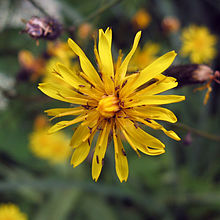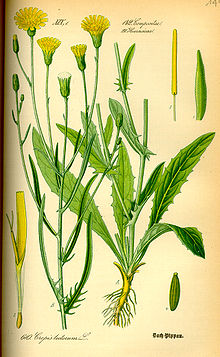- Crepis tectorum
-
Crepis tectorum 
Narrowleaf hawksbeard flower Scientific classification Kingdom: Plantae (unranked): Magnoliophyta (unranked): Magnoliopsida Order: Asterales Family: Asteraceae Genus: Crepis Species: C. tectorum Binomial name Crepis tectorum The Narrowleaf Hawksbeard, Crepis tectorum, is a annual or winter annual plant ranging from 30-100cm in height.[1] It is an invasive species and during maturity it has one main stem, which is branched, hairless, and leafy. The leaves are arranged in an alternate manner and are less than 0.5 inches wide. The Greek word “krepis” means sandal or slipper which resembles the shape of the seed.[2] Narrowleaf Hawksbeard orginated in Siberia and was introduced to Canada around 1890.[1]
Contents
Distribution
Crepis tectorum occurs all throughout Canada, northern parts of the continental United States, and Alaska. It was first discovered in 1974 in Fairbanks, Alaska. Narrowleaf Hawksbeard is now commonly found in the parkland zone of Alberta, Saskatchewan and Manitoba.[1] Crepis tectorum is found in waste areas, conventional tillage, reduced tillage, forage and hay fields, and roadsides.[3] [4]
Identification
Crepis tectorum is identified by its long, erect stem and yellow, dandelion-like flowers.[1] The leaves are pointed and lobed with a length of 10-15cm and width up to 4cm.[1] The flower heads look like they contain single flowers, but in fact they contain many ray florets. [[4]][1]
Seedling
Crepis tectorum may look similar to a dandelion at this stage but will have teeth that point downward on the underside leaf margin.[4] The cotyledons are oval and the first true leaves are more elongated with petioles.
Juvenile
The juvenile stage of the Narrowleaf Hawksbeard is distinguishable by its rosette (botany).[4] The stem may contain a milky-white substance.[4]
Mature
A mature Crepis tectorum plant will have dandelion-like flowers, with many flowers on each stem.[4] When the plant had gone to seed it will have a white, fluffy head where the flower used to be.[4] The stem will contain a milky-white substance.[4] The seeds are dark purple/brown achenes dispersed by the wind using hairs called Pappus (flower structure).[1]
Habitat and ecology
Crepis tectorum is an annual weed that grows in cultivated fields and roadsides. It is very invasive so it can take over a field and lead to serious ecological impacts for the surrounding. Crepis tectorum is able to grow in calcareous soil as well as soil that does not contain lime.[1] However, it grows best in nutrient rich soils containing clays and loams.[1] It also thrives in dry, coarse soil. It grows with other species in the wild however, it becomes infectious if not controlled by humans. It can easily be removed by hand, although it can be controlled better by chemical means. The presence of the Narrowleaf hawksbeard is damaging to the soil and other species of plants nearby as it generally takes over the area. The temperature range for germination is between 2-4 degrees Celsius with optimum depth of 3-4 cm.[5] narrow-leaved hawk'sbeard grows on both calcareous and limedeficient soils
Morphology
Individuals of this species are usually approximately 3 feet tall, single stemmed, yellow colored petals on flowers, and produce 30-70 yellow ray florets.
Flowers and fruit
Flowers of Crepis tectorum are approximately ½- ¾ inches wide and are hermaphrodite, having both male and female organs. It produces small flowers from June until September. The fruit is cylindrical shaped and dark brown. Crepis tectorum's fruit is dry and is called an achene.[1]
Methods of Control
Narrowleaf Hawksbeard responds best to a fall application of 2,4-DB herbicide.[1] Non-chemical methods of control include spring or fall tillage to control winter annuals and the correct use of agronomic practices such as fertilization for the control of annuals.[1] Biological control can be achieved by insects, non-domestic animals, microorganisms, and viruses.[1] However, the use of biological control can be risky and should always be approached with caution.
References
- ^ a b c d e f g h i j k l m [1]
- ^ [2]
- ^ al.], produced as a cooperative project with the U.S. Department of the Interior ... [et (2005). Invasive plants of Alaska. [Washington, D.C.]: U.S. Dept. of the Interior. pp. 63–65. ISBN 0160729963.
- ^ a b c d e f g [3]
- ^ "AgroAtlas". Crepis Tectorum. http://www.agroatlas.ru/en/content/weeds/Crepis_tectorum/.
Categories:
Wikimedia Foundation. 2010.

